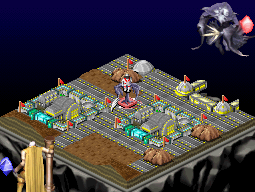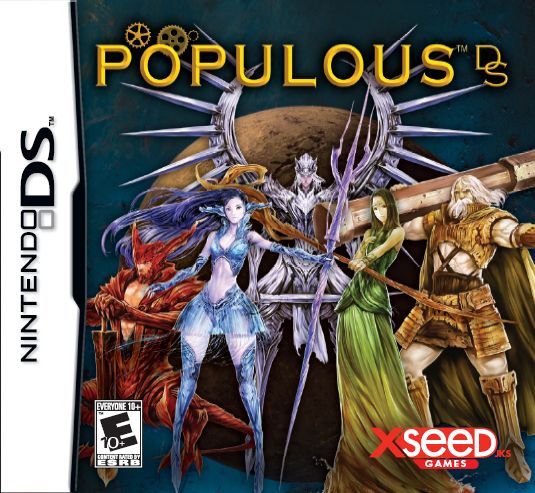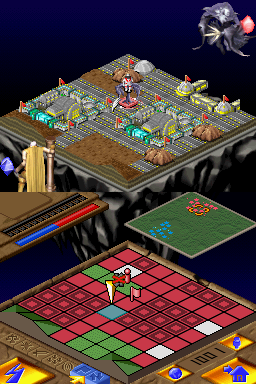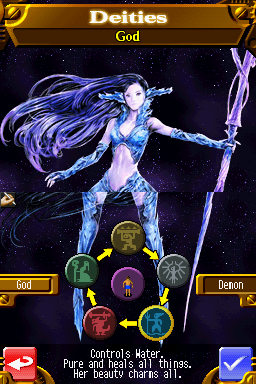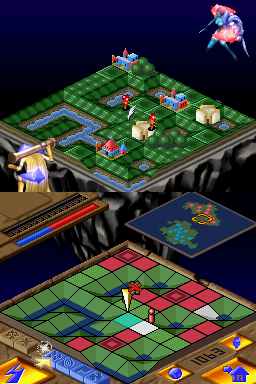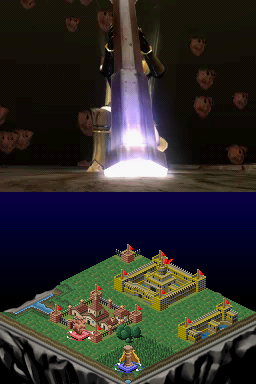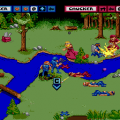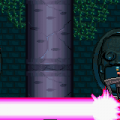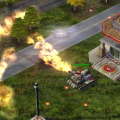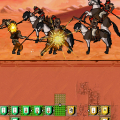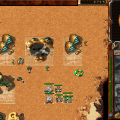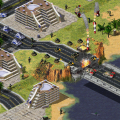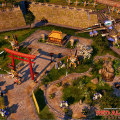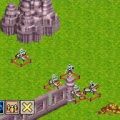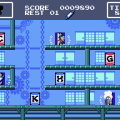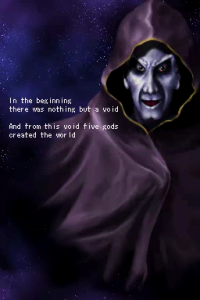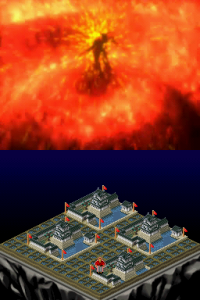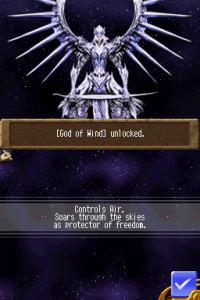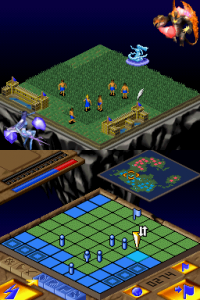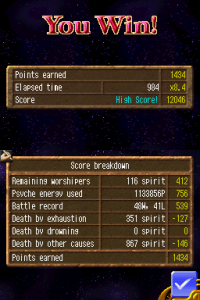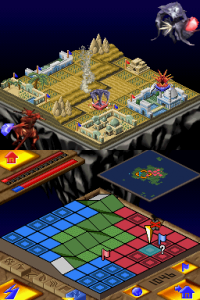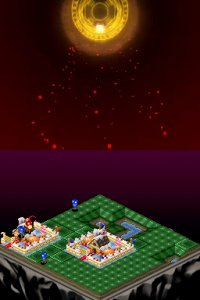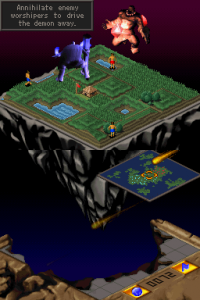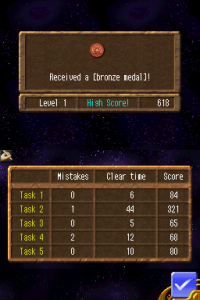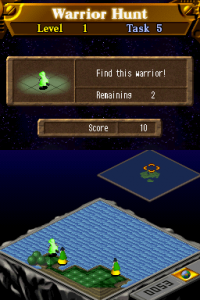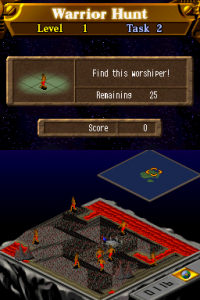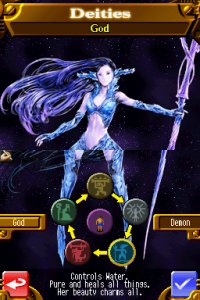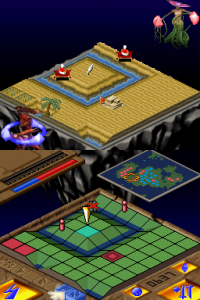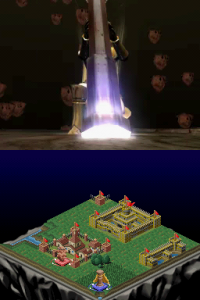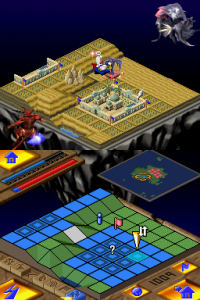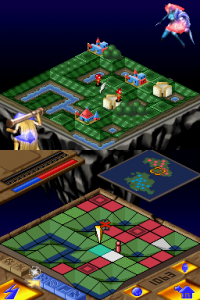For such a groundbreaking franchise, Populous has had its fair share of droughts. By the time Populous DS was published in 2008, nine years had already passed since the last title, releasing with little fanfair and even some disdain. And it’s not hard to see why it has faded into obscurity for an up-and-coming generation of gamers—younger players are more likely to know its main author, Peter Molyneux, for his Fable series, while other Bullfrog titles like Theme Park and Dungeon Keeper continue to have lasting appeal that far outstrips Populous.
In a way, this isn’t very surprising: these other ‘simulations’ represent fleshed-out, challenging experiences with thousands of moving parts, while Populous has always been a bit more primordial: grunting peeps wander single-mindedly on a map looking for flat land to build their homes, aided only by the repetitive one-click terraforming of their patron deity (the player). Wipe out the enemy, rinse, and repeat. Beyond a few special powers, there isn’t much more to it; Populous II added a welcome plethora of extra gods and alternative powers to play with, but the formula was in all respects identical. After an unorthodox diversion in Populous: The Beginning—which arguably did the most to infuse the franchise with new life (despite its laughable and cringeworthy premise)—it may have been thought that what Populous needed was a return to form.
Gamers might have doubts that Populous even needed such a revival, which would be the second in the series without any input from Molyneux or his co-creator Glenn Corpes. But it would find a curiously fitting home in the DS, where strategy titles from the flagship Advance Wars series to the likes of Age of Empires had been exploring HUD optimization on its Game’N’Watch-inspired dual screens. Eons before the likes of FarmVille and The Simpsons: Tapped Out ever had the misfortune of gracing our tablets and smartphones, Populous had players mindlessly clicking their lives away with gusto, and now with touch-pen in hand, the god sim promised to be even more tactile than before.
And while some might argue that Populous DS was better off without Molyneux—his penchant for hypberbole already threatening to overshadow the otherwise well-received Fable 1 and 2 – readers would do well to remember that the designer was still then a highly respected figure in the industry. Molyneux’s attention during this period was squarely set on the experimental, and he showed a continued willingness to steer away from current trends and easy cash cows, particularly in exploring the impact of moral choice in games. So while Populous did not see a direct sequel after The Beginning, that did not stop Molyneux from designing Black & White, a spiritual successor (and some say true sequel) to the series which took the industry by storm. Unwieldy, divisive, and either impressive or pompous depending on who you talked to, Black & White proved that the god sim still had more room to grow, and it would single-handedly carry the genre’s torch for a long time after.
Populous DS would have a different burden to bear: staying true to the god game that started it all, promising a kind of Populous fans hadn’t had since Populous II. With new game modes, updated graphics, and lots of extras, it should have been a home-run; it would practically take a deliberate effort on behalf of the developers to spoil this classic—albeit dated—experience. Unfortunately, that is precisely what Genki (known for its Tokyo Xtreme Racer series) and EA Japan did, turning Populous DS from an exciting comeback for old and new fans alike to a menial, bloated chore.
Gameplay
Somewhere between a remake and a remaster, Populous DS is essentially a streamlined port of the first game, heavily borrowing from Populous II and dubiously repackaged with an anime-CGI veneer (similar to Imagineer’s port of the second game to the Super Famicom). Its core conceits have not changed: build a community of settlers, exploit the ‘Mana’ energy they produce through worship, and exterminate the other side with a range of divine blights and miracles that allow you to transform the land and burn your enemies alive in turn. Unsurprisingly, the story is a mere pretense: five gods created the world but then fell into darkness; it is up to the player to restore order to this lost Eden; and so on. Actually interacting with the game-world is where it gets interesting, for Populous DS lives and dies by its touchscreen.
It is no secret that games for the DS are plagued by features that feel shoehorned in just to justify its driving gimmick, but terraforming with the touchscreen is so intuitive and so viscerally satisfying that it is a wonder the game ever used a mouse. Controls are responsive and swift, translating old Populous standbys like the ‘sprog’ (popping peeps out of their homes) and the ‘nipple’ (raising and levelling a hill to spawn an island or plateau) into elegant gestures or simple taps. Terraforming is streamlined further by the reappearance of the ‘Computer Assistant’ from Populous II (now mapped to the Y button), which flattens land around houses to help them grow. While it is less ambitious than the map-wide automation made possible in that game, it shows foresight to translate this useful feature to the DS as another ‘quality of life’ improvement. The game itself appears to be modelled on the original Populous engine, rendered as the ‘real’ map on the top screen. The bottom screen displays the world in a wire-frame mesh, with the ‘fat crosses’ of settlements visible at a glance, and key data—such as who are followers and who are leaders—in easy-to-grok symbolic shapes.
The trouble lies in this very contrast: Populous DS has actually managed to reverse, rather than solve, the ‘optional second screen’ problem by merely switching their places. The bottom screen is so useful, and so immediately responsive, that the 16-bit puppet show above is little more than ornamentation—and it doesn’t help that these graphics are loaded with unnecessary bells and whistles. During every match, blurry, pre-rendered gods endlessly hover in either corner of the top screen map with 1990s GIF-like sloth, apparently to remind players that they aren’t simply mashing squares and triangles into submission, but are actually locked in a holy battle for the ages. What’s more, the HUD appears to be modelled on the inferior Gameboy port of the first Populous, which collapsed most commands into a series of inane two-step submenus. Whatever Populous DS gains in screen real estate with this decision, it loses by being slow and unintuitive; even time-saving shortcuts like quick-cast icons in the lower left corner are exercises in frustration, for their small size makes mis-taps exceedingly common.
This inelegant cheesiness is made worse—and more generic—by the inclusion of budget-saving public domain hits like Ode to Joy in game-end Armageddon sequences, and the loss of much of the tongue-in-cheek religious language that coloured the first game. ‘Baptismal Fonts’ become ‘Brainwash Pools’ and ‘Papal Magnets’ merely ‘Symbols’; rather than a dark take on human religiosity, it looks like an attempt to turn Populous into a sci-fi OVA. At least Genki had the foresight to allow players to turn on the ‘heartbeat’ noise from the original game, as if to pre-empt fan complaints that it didn’t feel quite the same. But even still, what was no doubt a mechanical constraint that dictated the first Populous’ austere soundscape is now, with the benefit of large cartridges, an eerie anachronism.
But by far the game’s most unforgivable sin is the choice to interrupt the flow of play every single time a spell is cast with lengthy animations worthy of a 1990s Squaresoft RPG. These miracles are necessarily cast dozens—if not hundreds—of times throughout a match, and rather than play off the somewhat streamlined control scheme, they undo its work by drawing attention to this mandatory (and very ugly) hiccup, for no discernible ludic purpose. This kind of flair might be acceptable in turn-based titles like Advance Wars, but in the real-time frenetics of a Populous match, it only serves to kill momentum. The mind-numbing tedium of this design choice in an age in which games already were allowing players to turn things like this off is disappointing, to say the least.
And speaking of tedium—players can’t even begin playing the game itself until they are subjected to a sort of rack of didactic tortures, straight from that most obtuse and distrusting school of game design that reigns in these kinds of conservative ports. Rather than have one map which explains each function successively, all game mechanics are divided into individual levels, and players are forced to read up, enter, and complete each of these ‘challenges’ before progressing to the main game. Some of these tutorials last only seconds as they amount to things like clicking a menu button, or raising/lowering the land once. Along with the vapid ‘Warrior Hunt’ mode—which is little more than Where’s Waldo using the Populous engine—these design choices feel like an attempt to artificially inflate the game content. And they unforgivably delay the instant gratification of the vaunted god-sim by excruciating minutes—centuries in preciously-budgeted game time.
As for the main campaign, it sports around fifty maps, split into ‘levels’ of five each, which hail mainly from the original Populous catalogue. Fans will note familiar settings which featured in various Populous ports and expansions, from Japanesque castles (‘Yamato’) to the classic ‘Bit Plains’—this time with contemporary Wiis, Gamecubes, and DSes for buildings. New map types like ‘Horror’ and ‘Fairytale’ are eyesores, and show that Genki is nothing if not consistent. While each biome does differ in terms of climate (wandering peeps are quicker to perish in harsher climates, and quicker to build in others) and topography (some are flatter or and some more mountainous), they are effectively reskins of each other. This is nothing new for Populous, but switching maps—and types of divine opponents—keeps the game fresh enough that more forgiving players will soldier on if only to see what else the game has to offer.
The gods themselves are a mix of direct copies and remixes of elemental power sets from the second game. The starting Earth god, for example, is nearly identical to his elemental counterpart, but he wields a new, crater-punching ‘Meteorite’ power, while the Water god’s new draw is his ‘Typhoon’ ability, which happens to be one of the most overpowered miracles in the game. There is some fun in poking around with these new skills, but most will be familiar to older Populous fans. Each god also has their respective ‘Warrior’, which takes inspiration from the second game’s mythical heroes but function more like the first game’s Knights. Their powers here are much more straightforward: the Warrior of Earth turns enemy peeps and settlements into rocks, the Warrior of Fire sets them on fire, and so on. While there are some hold-overs from Populous II, they are far less unwieldy and experimental here. All gods are balanced in an elemental circle that usually makes facing off against a god of the same type a losing proposition (at least at the outset), encouraging players to branch out and learn each type early on.
But the real (and short-lived) joy is that these abilities are superimposed onto the simple engine from the first Populous, making this—in theory—a far more interesting way to play the first game than slogging through the original or any of its dated ports. More importantly, Populous DS features an accessible multiplayer mode which revives some of the original mischievous, anarchic spirit of the game in the company of other humans. It is the game’s biggest saving grace, and it even allows up to four friends to play at the same time, something never before possible in the early Populous engines. But all of this is still wrapped in a queasy, tiresome package, marred by misguided design choices which make it unplayable for more than a few minutes at a time.
Conclusion
Populous DS thunderously addresses players from the box with the byline, “The power of the Gods in your hands”; in reality, it is “somewhere between a time-waster and a strategy game”, in 1UP’s words. It is an uneven experience at best and kitschy at worst. It feels rushed and it shows—but it also must be said that were it not specifically for its atrocious, non-stop animations, Populous DS may just have been the definitive way to play this classic game, warts and all.
For while the art department appears to have been charged with the gaming equivalent of selling Sea-Monkeys, the core design team was not far off from a perfect mix of Populous I and II. This is especially tragic given how poorly the original Amiga title has aged; it has been so thoroughly superseded by both imitators and its own sequels that playing it today is more academic than fun.
The sad truth is that Populous DS simply does not meet industry standards, now or at the time of its release. It is an embarrassing blip in Populous history, crying out to be hacked and souped up by an obscure fan community into the game it should have been.
